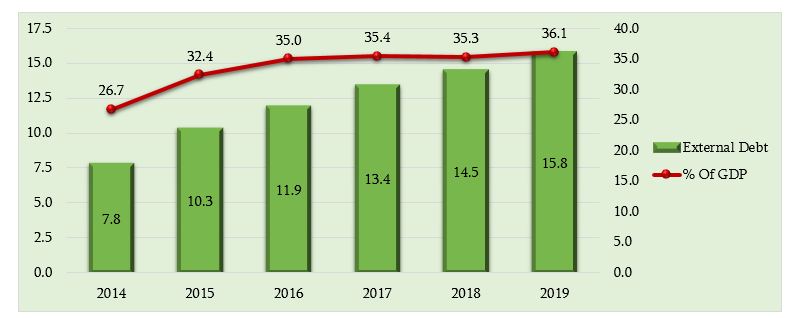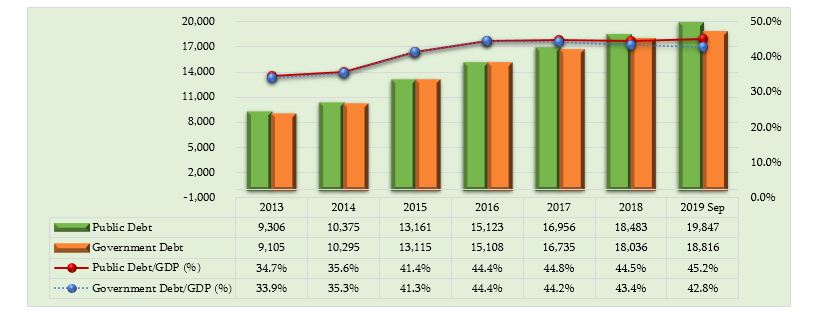Resume: The absolute figure of Georgia’s External debt in 2019 has almost doubled as compared to 2014 and increased by GEL 8 billion. However, whilst discussing debt, it is appropriate to analyse relative instead of absolute figures. Theoretically, whilst having a discussion on “how much debt a new-born baby has” (debt per capita), we have to take into consideration that the “average incomes of new-born babies” in 2019 (GDP per capita) has also increased as compared to 2014. In the same period, the relative figure of External debt has not doubled and in fact increased by a factor of 1.35.
In regard to the figures named by Zurab Tchiaberashvili himself, they are close to the total Public debt to population ratio and not to the External debt. Later, FactCheck was given a clarification that Mr Tchiaberashvili had not meant External debt but the total Public debt which is the sum of domestic and External debts.
The total Public debt amounts to nearly GEL 19.8 billion which is indeed twice as much as compared to 2014’s figure. However, the relative figure has increased only by a factor of 1.27 instead of being doubled and the government debt[1] dynamic is also similar. In regard to the total and External debt per capita, both the total Public debt and the External debt has nearly doubled as compared to 2014. In 2019, the total Public debt per capita was approximately GEL 5,330 whilst the External debt per capita was GEL 4,250. In 2014, the total Public debt per capita was approximately GEL 2,792 whilst the External debt per capita was GEL 2,106.
When making reference to the growth of debt, it is necessary to take into consideration the fluctuation of the GEL exchange rate in the given period. In particular, when the exchange rate changes at the end of a period, it is not only the added debt in a given period (debt taken in a year) that is calculated with the new exchange rate but also the total debt accumulated for that particular moment. Therefore, debt growth is largely stipulated by a recalculation of debt taken in the past with the new exchange rate.
Analysis
European Georgia – Movement for Freedom MP, Zurab Tchiaberashvili, in his speech before the Parliament of Georgia, stated: “If we take 2014’s data, External debt only: in 2014, each baby in this country was born with GEL 2,630 in debt whilst in 2019 every baby is born with GEL 5,200 in debt. The External debt has doubled.”
Georgia’s Public domestic debt includes the part of the total debt denominated in the national currency whilst External debt is denominated in a foreign currency. As compared to 2014, the total figure of the External debt has increased in 2019 (largely owing to the change in the exchange rate) by nearly GEL 8 billion. External debt statistics are shown in Graph 1.
Of note is that whilst discussing debt, it is appropriate to analyse the relative instead of the absolute figures. This is because the specific absolute number could be very big for a small economy and very small for a comparatively large economy. Theoretically, whilst having a discussion on “how much debt a new-born baby has” (debt per capita), we have to take into consideration that the “average incomes of new-born babies” in 2019 (GDP per capita) has also increased as compared to 2014. In order to adequately assess the debt burden, it is commonly accepted to look at the total debt to GDP ratio. As compared to 2014, the relative figure of External debt has not doubled and in fact increased by a factor of nearly 1.35.
Graph 1: Public External Debt (GEL Billion) GDP % (Estimated GDP for 2019)

Source: Ministry of Finance of Georgia
In regard to figures named by Zurab Tchiaberashvili himself, they are close to the total Public debt to population ratio and not to the External debt. Later, FactCheck was given a clarification that Mr Tchiaberashvili had indeed meant the total Public debt and not the External debt which is the sum of the domestic and the External debts. The politician’s statement delivered in the Parliament of Georgia contained a technical error. The statistics of the total Public debt and the government debt are shown in Graph 2.
Graph 2: Public Debt and Government Debt (GEL Million, GDP %, Estimated GDP for 2019)

Source: Ministry of Finance of Georgia
The total Public debt amounts to nearly GEL 19.8 billion which is indeed twice as much as compared to 2014’s figure. However, the relative figure has increased only by a factor of 1.27 instead of being doubled and the government debt dynamic is also similar. In regard to the total and the External debt per capita, the respective figures are shown in Graph 1. As compared to 2014, both the total Public debt and the External debt per capita have nearly doubled. In 2019, the total Public debt per capita was approximately GEL 5,330 whilst the External debt per capita was GEL 4,250. In 2014, the total Public debt per capita was approximately GEL 2,792 whilst the External debt per capita was GEL 2,106.
Table 1: Total Public Debt and Total External Debt Per Capita in 2014-2019 (GEL Thousand)

Source: Ministry of Finance of Georgia
When making reference to the growth of debt, it is necessary to take into consideration the fluctuation of the GEL exchange rate in the given period. In particular, when the exchange rate changes at the end of a period, it is not only the added debt in a given period (debt taken in a year) that is calculated with the new exchange rate but the total debt accumulated for that particular moment. Therefore, debt growth is largely stipulated by a recalculation of the debt taken in the past with the new exchange rate.
[1] The total Public debt is the sum of the total External debt (including the debt of the National bank) and the domestic debt. The total government debt, in contrast to the Public debt, does not include the obligations of the national bank.








